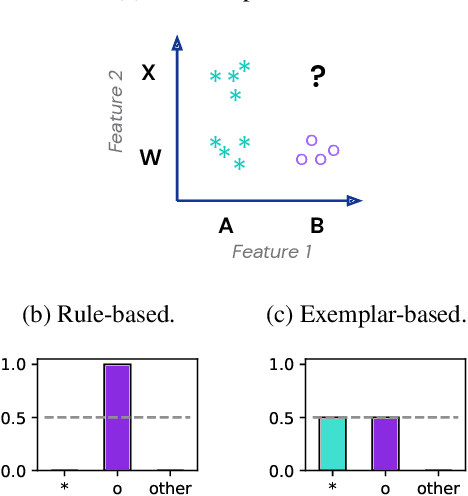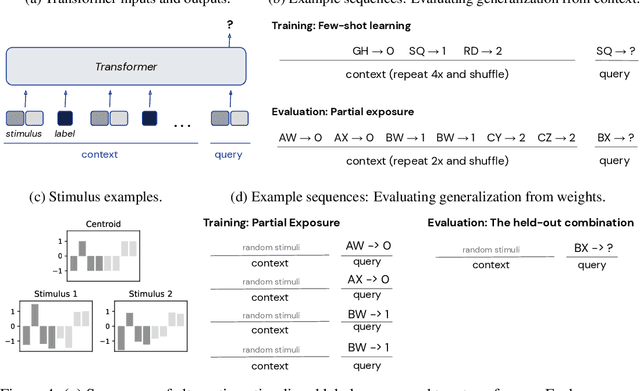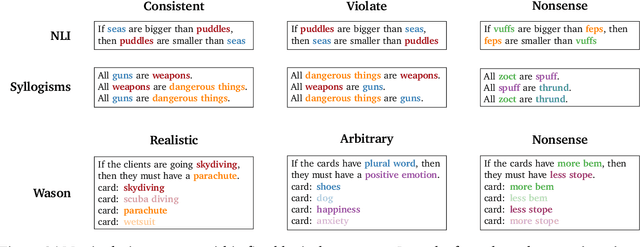Andrew K. Lampinen
On the generalization of language models from in-context learning and finetuning: a controlled study
May 01, 2025Abstract:Large language models exhibit exciting capabilities, yet can show surprisingly narrow generalization from finetuning -- from failing to generalize to simple reversals of relations they are trained on, to missing logical deductions that can be made from trained information. These failures to generalize from fine-tuning can hinder practical application of these models. However, language models' in-context learning shows different inductive biases, and can generalize better in some of these cases. Here, we explore these differences in generalization between in-context- and fine-tuning-based learning. To do so, we constructed several novel datasets to evaluate and improve models' ability to generalize from finetuning data. The datasets are constructed to isolate the knowledge in the dataset from that in pretraining, to create clean tests of generalization. We expose pretrained large models to controlled subsets of the information in these datasets -- either in context, or through fine-tuning -- and evaluate their performance on test sets that require various types of generalization. We find overall that in data-matched settings, in-context learning can generalize more flexibly than fine-tuning (though we also find some qualifications of prior findings, such as cases when fine-tuning can generalize to reversals embedded in a larger structure of knowledge). We build on these findings to propose a method to enable improved generalization from fine-tuning: adding in-context inferences to finetuning data. We show that this method improves generalization across various splits of our datasets and other benchmarks. Our results have implications for understanding the inductive biases of different modes of learning in language models, and practically improving their performance.
Decoupling the components of geometric understanding in Vision Language Models
Mar 05, 2025Abstract:Understanding geometry relies heavily on vision. In this work, we evaluate whether state-of-the-art vision language models (VLMs) can understand simple geometric concepts. We use a paradigm from cognitive science that isolates visual understanding of simple geometry from the many other capabilities it is often conflated with such as reasoning and world knowledge. We compare model performance with human adults from the USA, as well as with prior research on human adults without formal education from an Amazonian indigenous group. We find that VLMs consistently underperform both groups of human adults, although they succeed with some concepts more than others. We also find that VLM geometric understanding is more brittle than human understanding, and is not robust when tasks require mental rotation. This work highlights interesting differences in the origin of geometric understanding in humans and machines -- e.g. from printed materials used in formal education vs. interactions with the physical world or a combination of the two -- and a small step toward understanding these differences.
The in-context inductive biases of vision-language models differ across modalities
Feb 03, 2025Abstract:Inductive biases are what allow learners to make guesses in the absence of conclusive evidence. These biases have often been studied in cognitive science using concepts or categories -- e.g. by testing how humans generalize a new category from a few examples that leave the category boundary ambiguous. We use these approaches to study generalization in foundation models during in-context learning. Modern foundation models can condition on both vision and text, and differences in how they interpret and learn from these different modalities is an emerging area of study. Here, we study how their generalizations vary by the modality in which stimuli are presented, and the way the stimuli are described in text. We study these biases with three different experimental paradigms, across three different vision-language models. We find that the models generally show some bias towards generalizing according to shape over color. This shape bias tends to be amplified when the examples are presented visually. By contrast, when examples are presented in text, the ordering of adjectives affects generalization. However, the extent of these effects vary across models and paradigms. These results help to reveal how vision-language models represent different types of inputs in context, and may have practical implications for the use of vision-language models.
Aligning Machine and Human Visual Representations across Abstraction Levels
Sep 10, 2024Abstract:Deep neural networks have achieved success across a wide range of applications, including as models of human behavior in vision tasks. However, neural network training and human learning differ in fundamental ways, and neural networks often fail to generalize as robustly as humans do, raising questions regarding the similarity of their underlying representations. What is missing for modern learning systems to exhibit more human-like behavior? We highlight a key misalignment between vision models and humans: whereas human conceptual knowledge is hierarchically organized from fine- to coarse-scale distinctions, model representations do not accurately capture all these levels of abstraction. To address this misalignment, we first train a teacher model to imitate human judgments, then transfer human-like structure from its representations into pretrained state-of-the-art vision foundation models. These human-aligned models more accurately approximate human behavior and uncertainty across a wide range of similarity tasks, including a new dataset of human judgments spanning multiple levels of semantic abstractions. They also perform better on a diverse set of machine learning tasks, increasing generalization and out-of-distribution robustness. Thus, infusing neural networks with additional human knowledge yields a best-of-both-worlds representation that is both more consistent with human cognition and more practically useful, thus paving the way toward more robust, interpretable, and human-like artificial intelligence systems.
SODA: Bottleneck Diffusion Models for Representation Learning
Nov 29, 2023Abstract:We introduce SODA, a self-supervised diffusion model, designed for representation learning. The model incorporates an image encoder, which distills a source view into a compact representation, that, in turn, guides the generation of related novel views. We show that by imposing a tight bottleneck between the encoder and a denoising decoder, and leveraging novel view synthesis as a self-supervised objective, we can turn diffusion models into strong representation learners, capable of capturing visual semantics in an unsupervised manner. To the best of our knowledge, SODA is the first diffusion model to succeed at ImageNet linear-probe classification, and, at the same time, it accomplishes reconstruction, editing and synthesis tasks across a wide range of datasets. Further investigation reveals the disentangled nature of its emergent latent space, that serves as an effective interface to control and manipulate the model's produced images. All in all, we aim to shed light on the exciting and promising potential of diffusion models, not only for image generation, but also for learning rich and robust representations.
Getting aligned on representational alignment
Nov 02, 2023Abstract:Biological and artificial information processing systems form representations that they can use to categorize, reason, plan, navigate, and make decisions. How can we measure the extent to which the representations formed by these diverse systems agree? Do similarities in representations then translate into similar behavior? How can a system's representations be modified to better match those of another system? These questions pertaining to the study of representational alignment are at the heart of some of the most active research areas in cognitive science, neuroscience, and machine learning. For example, cognitive scientists measure the representational alignment of multiple individuals to identify shared cognitive priors, neuroscientists align fMRI responses from multiple individuals into a shared representational space for group-level analyses, and ML researchers distill knowledge from teacher models into student models by increasing their alignment. Unfortunately, there is limited knowledge transfer between research communities interested in representational alignment, so progress in one field often ends up being rediscovered independently in another. Thus, greater cross-field communication would be advantageous. To improve communication between these fields, we propose a unifying framework that can serve as a common language between researchers studying representational alignment. We survey the literature from all three fields and demonstrate how prior work fits into this framework. Finally, we lay out open problems in representational alignment where progress can benefit all three of these fields. We hope that our work can catalyze cross-disciplinary collaboration and accelerate progress for all communities studying and developing information processing systems. We note that this is a working paper and encourage readers to reach out with their suggestions for future revisions.
Evaluating Spatial Understanding of Large Language Models
Oct 23, 2023Abstract:Large language models (LLMs) show remarkable capabilities across a variety of tasks. Despite the models only seeing text in training, several recent studies suggest that LLM representations implicitly capture aspects of the underlying grounded concepts. Here, we explore LLM representations of a particularly salient kind of grounded knowledge -- spatial relationships. We design natural-language navigation tasks and evaluate the ability of LLMs, in particular GPT-3.5-turbo, GPT-4, and Llama2 series models, to represent and reason about spatial structures, and compare these abilities to human performance on the same tasks. These tasks reveal substantial variability in LLM performance across different spatial structures, including square, hexagonal, and triangular grids, rings, and trees. We also discover that, similar to humans, LLMs utilize object names as landmarks for maintaining spatial maps. Finally, in extensive error analysis, we find that LLMs' mistakes reflect both spatial and non-spatial factors. These findings suggest that LLMs appear to capture certain aspects of spatial structure implicitly, but room for improvement remains.
Improving neural network representations using human similarity judgments
Jun 07, 2023Abstract:Deep neural networks have reached human-level performance on many computer vision tasks. However, the objectives used to train these networks enforce only that similar images are embedded at similar locations in the representation space, and do not directly constrain the global structure of the resulting space. Here, we explore the impact of supervising this global structure by linearly aligning it with human similarity judgments. We find that a naive approach leads to large changes in local representational structure that harm downstream performance. Thus, we propose a novel method that aligns the global structure of representations while preserving their local structure. This global-local transform considerably improves accuracy across a variety of few-shot learning and anomaly detection tasks. Our results indicate that human visual representations are globally organized in a way that facilitates learning from few examples, and incorporating this global structure into neural network representations improves performance on downstream tasks.
Transformers generalize differently from information stored in context vs in weights
Oct 11, 2022



Abstract:Transformer models can use two fundamentally different kinds of information: information stored in weights during training, and information provided ``in-context'' at inference time. In this work, we show that transformers exhibit different inductive biases in how they represent and generalize from the information in these two sources. In particular, we characterize whether they generalize via parsimonious rules (rule-based generalization) or via direct comparison with observed examples (exemplar-based generalization). This is of important practical consequence, as it informs whether to encode information in weights or in context, depending on how we want models to use that information. In transformers trained on controlled stimuli, we find that generalization from weights is more rule-based whereas generalization from context is largely exemplar-based. In contrast, we find that in transformers pre-trained on natural language, in-context learning is significantly rule-based, with larger models showing more rule-basedness. We hypothesise that rule-based generalization from in-context information might be an emergent consequence of large-scale training on language, which has sparse rule-like structure. Using controlled stimuli, we verify that transformers pretrained on data containing sparse rule-like structure exhibit more rule-based generalization.
Language models show human-like content effects on reasoning
Jul 14, 2022



Abstract:Abstract reasoning is a key ability for an intelligent system. Large language models achieve above-chance performance on abstract reasoning tasks, but exhibit many imperfections. However, human abstract reasoning is also imperfect, and depends on our knowledge and beliefs about the content of the reasoning problem. For example, humans reason much more reliably about logical rules that are grounded in everyday situations than arbitrary rules about abstract attributes. The training experiences of language models similarly endow them with prior expectations that reflect human knowledge and beliefs. We therefore hypothesized that language models would show human-like content effects on abstract reasoning problems. We explored this hypothesis across three logical reasoning tasks: natural language inference, judging the logical validity of syllogisms, and the Wason selection task (Wason, 1968). We find that state of the art large language models (with 7 or 70 billion parameters; Hoffman et al., 2022) reflect many of the same patterns observed in humans across these tasks -- like humans, models reason more effectively about believable situations than unrealistic or abstract ones. Our findings have implications for understanding both these cognitive effects, and the factors that contribute to language model performance.
 Add to Chrome
Add to Chrome Add to Firefox
Add to Firefox Add to Edge
Add to Edge